| Article ID | Journal | Published Year | Pages | File Type |
|---|---|---|---|---|
| 2100786 | Best Practice & Research Clinical Haematology | 2008 | 17 Pages |
Allogeneic stem cell transplantation remains a curative treatment for haematological malignancies resistant to other treatment approaches through the unique graft-versus-leukaemia effect (GvL). However, the lack of specificity of this response results in the targeting of normal tissue, and the morbidity and mortality associated with graft-versus-host disease (GvHD). Further improvements in exploiting the GvL effect to prevent relapse in high-risk leukaemias while minimizing toxicity have focused on the use of targeted anti-leukaemic immunotherapy. These strategies include the use of vaccines against minor histocompatibility antigens (HA-1, HA-2 and H-Y) and leukaemia-specific antigens (proteinase 3, Wilms' tumour 1 and BCR-ABL), and the adoptive transfer of leukaemia-specific T cells. The unique post-transplant milieu, which is characterized by lymphopenia, regulatory T-cell depletion and the release of growth factors, offers the opportunity to promote the expansion of engrafted T cells and enhance the specific GvL response. Techniques to reduce regulatory T-cell control over T-cell responses to leukaemia antigens could further enhance GvL reactivity. Finally, these approaches to increase GvL effects would be facilitated by transplant approaches to deplete GvHD alloresponses selectively while preserving GvL reactivity.
